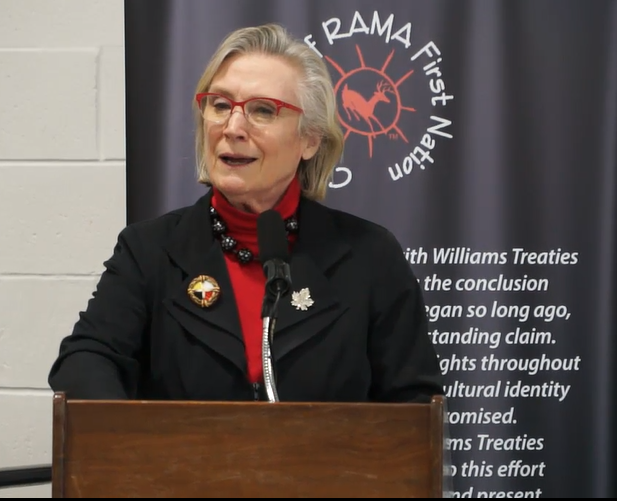A “dark chapter” of this country’s history has finally come to a close and a new chapter, “where trust can be rebuilt,” will now be opened, say officials after the signing of an historic treaty claim settlement in Rama Saturday.
The Williams Treaty Claim Settlement, agreed to in September, was officially signed by Rama and six other First Nations, known as the Williams Treaties First Nations, at the Rama MASK Saturday. The agreement is meant to rectify the “injustices” of the 1923 Williams Treaty; it has been years in the making.
The new pact includes $1.11 billion in compensation - $666 million from the federal government and $444 from the province. It also entitles each of the First Nations to add up to 11,000 acres of land to their reserves and ensures they can restore historic harvesting rights.
Underpinning the settlement is an apology from both the province and the federal government.
“We are sorry,” said Carolyn Bennett, the federal minister of Crown/Indigenous Relations, who expressed the apology on behalf of Prime Minister Justin Trudeau and the government.
Bennett noted the original treaty of 1923 was “intended to resolve long-standing claims” but, instead, “continued injustices, (provided) insufficient compensation and inadequate reserve lands” and did not allow these communities to “freely exercise traditional harvesting rights.”
Bennett acknowledged the Crown’s actions “did not honour” the longstanding rights of First Nations people. “We are sorry these treaties did not resolve” these problems and “failed to recognize and respect your treaty rights.”
She said there “is no way to undo the past nor to fully atone for the wrongs perpetrated” to people in these communities.
However, she said the new settlement is “an opportunity to open a new chapter where trust can be rebuilt, where the Anishinaabe culture can be respected. We are committed to writing this next chapter together in the spirit of reconciliation and partnership.”
The provincial government also apologized at the well-attended ceremony that included municipal leaders from many Simcoe County communities in addition to chiefs and council members from the seven Williams Treaties First Nations.
“As the Minister of the Crown for Ontario, I offer to you today an apology,” said Greg Rickford. “We are sorry for this hardship and sorrow and other negative impacts caused by the Williams Treaty.”
The provincial minister thanked the negotiating teams “who worked tirelessly to close this dark chapter in our province’s history.” He said many have worked long and hard, for years, to help ensure this new treaty was signed.
“My commitment (is) to make reconciliation real and to ensure provincial efforts” continue to be “grounded in making a difference” in the lives of First Nations people.
Many wondered if this day would ever come, conceded former Rama chief Lorraine McRae, an elder who was asked to provide remarks at Saturday’s ceremony.
“It is so amazing to be alive at this time and to be a witness to this very important treaty settlement,” said McRae. “We also know and feel the pain and suffering from our families and communities.”
She said the community has “grieved the loss of our relationship to our lands, our language and culture and way of life.” She also noted the pain that lies beneath those impacted by addictions, homelessness, poverty and those who are missing or lost.
“But history continues to be written and we do have hope for a good future,” said McRae.
Rama chief Rodney Noganosh agreed.
The settlement “marks the end of the struggle and the beginning of a shared path with both Canada and Ontario,” said Noganosh. This “bodes well for our future” and represents “an opportunity to renew the practices of our ancestors” and “to rediscover our culture and our history.”
However, he also stressed much work still must be done to implement the terms of the treaty.
"An apology is not automatically accepted," he said, noting it must be accompanied by action and implementation.
"We will take many generations to recover," said Noganosh, who has been involved in the treaty process during the four years he has served as chief and the 18 years he served as a councillor. "It's been a long and exhausting process."
The process will continue. "There is a lot of work ahead ... as we move along the healing path," said Noganosh. "It is a pivotal time in our collective history."
Ironically, the day that Rama Councillor Ron Douglas visited McRae, bringing sacred tobacco, and asking her to speak at the signing of the treaty, was the same day McRae finished writing a song about reconciliation.
“The eight basic needs and those Seven Grandfather teachings inspired this song,” McRae told those gathered Saturday. In the song’s refrain are three questions: Do you see me? Do you hear me? Do you love me?
On Saturday, she changed that last question to: Do you accept me? And then, she sang the song, quietly but emotionally. It was a song Rickford later said was “one of the best songs” he had ever heard.
McRae challenged those in attendance to make the song a personal song and adopt its message so that they might “live in peace and harmony.”
The seven Williams Treaties First Nations are: Alderville First Nation, Beausoleil First Nation, Chippewas of Georgina Island, Chippewas of Rama, Curve Lake First Nation, Hiawatha First Nation and Mississaugas of Scugog Island.
Saturday’s ceremony included traditional native drummers and singing and was followed by a community feast.
